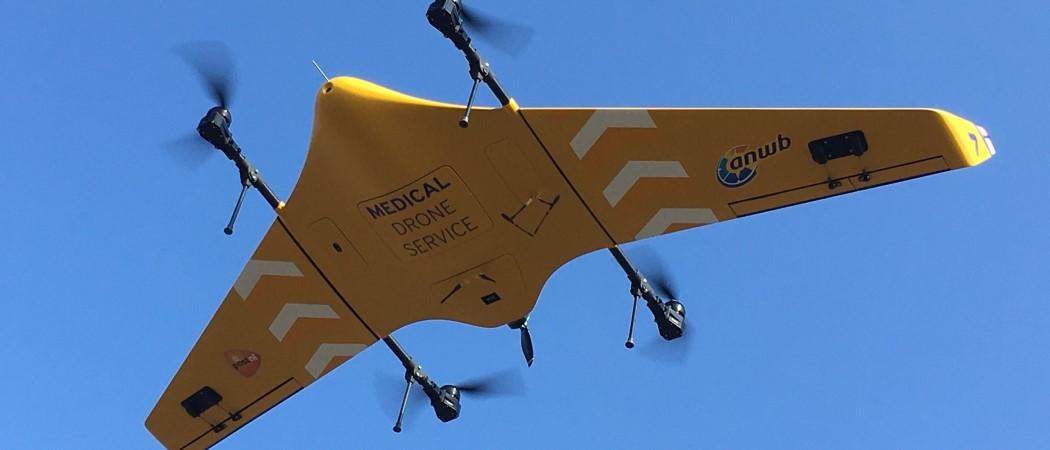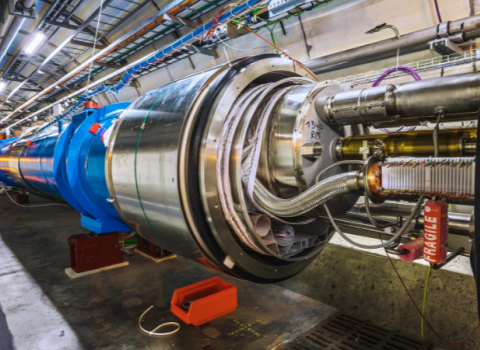The next frontier - U-space - designated airspace for use by drones, is opening up. This raises the prospect of airborne home deliveries, once service providers are in place to manage traffic

EU rules on managed airspace for drones, called U-space, came into force at the end of January. It is now down to governments to designate their U-space areas and service providers, with a view to full implementation by 2030. The change is significant for drone start-ups.
“Now there is no question over whether or not beyond-line-of-sight home deliveries will be allowed, all over Europe. It’s in the law,” said Herman Øie Kolden, co-founder and head of operations with Norwegian start-up Aviant. “So, it opens the door, but we have to show that we can walk through it.”
At the same time, the question of how the rules will be implemented remains open for most European countries. “Right now, we are in regulatory limbo,” said Matthijs Damen, head of engineering with Dutch start-up Avy. “We don’t know what to comply with in the future, or which U-space service providers are going to be designated in a certain part of the airspace where we want operate.”
EU rules for civil drones came into force at the end of 2020, dividing operations into three categories depending on the risk involved, with each requiring different levels of authorisation and pilot licensing. These were followed in 2021 by the U-space regulation, which specifies a set of services and other measures to be deployed in airspace with heavier drone traffic and where crewed and uncrewed aircraft will both operate.
These services involve a high level of digitalisation and automation, and include registration and identification, flight planning and approval, interactions with conventional air traffic control, and conflict detection.
U-space is not necessary for companies to offer drone services in urban areas, but it brings a great deal of clarity to their operation. “You need to have rules, and everyone needs to fit into those rules, and that’s where U-space is important,” said Bobby Healy, founder and chief executive of Manna. “It’s about doing it properly, in black and white, with no potential for human error, in a scalable way.”
Wide open door
All users of the airspace come under the same system. “Where it helps is [the] explicit declaration that airspace is now mixed, between drones and general aviation. It brings the general aviation population into the technology side of things, and recognises that we are there,” said Healy.
Founded in 2018, Manna is already making hundreds of home deliveries by drone each week in Balbriggan, a town near Dublin. Healy foresees expanding in the next year or so, which could line up well with the deployment of U-space in Ireland. U-space will also be a guide when the company looks to scale in the rest of Europe. “The fact that a market has implemented U-space services is a wide open door,” Healy said. “It shows that, at a government level, they want that airspace commercialised, they want the jobs and the commerce that goes with it.”
The designation of U-space areas is also the key to Aviant’s expansion beyond Norway. “It is simply a prerequisite in order for us to be able to scale efficiently,” said Kolden.
Aviant was founded at the beginning of 2020 by three students from the Norwegian University of Science and Technology, who met while on the advanced study programme at the Massachusetts Institute of Technology. Already working together on drone applications, the COVID-19 pandemic prompted them to focus on medical logistics in their home country. They developed and tested their vertical take-off drone at MIT, and then returned to Norway to start testing services.
Based in Trondheim, with a staff of around 20 people, Aviant’s most recent seed funding round in November 2022 secured $2.3 million. During 2021 and 2022 the company operated 10 commercial contracts, delivering medical supplies and samples over distances up to 120km. Most recently, it has also started a home delivery service, operating within a 30km radius in the city of Trondheim.
Designating U-space areas
While 26 January fired the starting pistol for designation of U-space areas, it will take some time before they become a reality. Even the most enthusiastic states have still to bring the regulations into national law, and progress after that will depend on cities deciding to embrace the proposition.
The initial focus will be on demonstration projects. Past demonstrators, such as the U-space sandbox set up in the Port of Hamburg during 2021, had a limited scope and nowhere to go once concluded. The situation is different for the AMIUS project that started in January 2022, testing U-space around Ingolstadt and Manching in Bavaria. If successful, this is expected to transition easily into a permanent U-space.
Drone companies keen to scale-up in Europe are watching these demonstration projects as a way of anticipating the appearance of designated U-space areas, expected to be operating from 2024 onwards. “We want to expand into Europe earlier than that, so now we are looking for the most suitable small U-space projects that support commercial use cases, so that we can make a start,” Kolden says.
Getting involved in these early projects will give companies such as Aviant valuable experience and perhaps a head start once formal designation gets underway. The same goes for its competitors, of course, but Kolden is unconcerned. “The regulations are pretty clear that, once a U-space area is operational, it has to be open to all. And in the short term, I’m happy to cheer for the people who are making progress.”
Plus, the more companies take part, the quicker outstanding questions about common standards will shake out, which will benefit the whole industry.
For Avy the picture is a little more mixed. Once U-space areas appear, there will be greater clarity in the regulations it has to follow and which third parties its drone platform will have to integrate with, particularly the U-space service providers (USSPs). But how the U-space areas are implemented is crucial.
“If 600 different small sections of airspace get designated, it becomes very convoluted and problematic for us, because we will probably have to integrate with a huge number of different USSPs,” said Damen. “But if it is done on a large scale, with large areas dedicated to the same U-space provider, with clear integration requirements, then it is definitely beneficial.”
Avy makes fixed wing vertical take-off drones for applications such as healthcare logistics and emergency response. Founded in 2016, it presently has around 55 employees and has developed with the support of a €1.4 million grant from the European Innovation Council’s Accelerator programme and a sizable investment from an angel investor. It is currently preparing a series A funding.
At the same time, early participation carries a risk for the drone companies, since the engineering work involved in integrating a drone platform with a USSP is not trivial. A company like Avy wants to know that the resources invested are worthwhile.
“We don’t want to do the integration work with many different USSPs, each as a one-off engineering project,” said Damen. “We want to make an application programming interface that is flexible, that that can work with multiple USSPs, so our clients are also free to operate in airspace that is designated to different USSPs.”
This lack of clarity can also make participating in U-space test or demonstration projects less attractive, since the service provider involved might not be chosen to implement the actual U-space areas. “Doing quite a lot of engineering work to integrate with a USSP on a trial basis becomes a risk for us, if we don’t know that it has any future benefits.”
While the arrival of U-space is clearly a benefit for civil drones in Europe, it does not solve all the industry’s problems. Most significant for Healy is the lack of capital to support the growth that the regulations now make possible. “It’s the kind of industry where you need hundreds of millions of dollars not fives or tens of millions, and unfortunately Europe just doesn’t have that level of risk capital available,” he said.
The natural place to look for that investment is the US, but attitudes there are set by the domestic market. “The US is years behind Europe in readiness to do anything with drone delivery at scale,” Healy said. “And that’s probably the biggest thing holding back growth of the European industry: a lack of clarity in the US about where the industry is going.”
Aviant meanwhile has questions about what happens between the U-space areas, which are intended to be set up only in locations with heavy drone activity. “What are you going to do about integrating manned and unmanned flights when there is no airspace structure? It’s uncontrolled airspace, and by definition that means anybody can fly in it,” Kolden said.
This is also a concern for Wingcopter, a German start-up founded in 2017, whose aircraft are designed to fly missions in the 100km range, for example connecting rural health facilities with central laboratories. “This will likely exceed the boundaries of individual U-spaces, and therefore we are developing our technology to allow for safe beyond-visual-line-of-sight flights outside of U-spaces as well,” said Ansgar Kadura, co-founder of the company and its chief services officer. “But in this case the U-space does not (yet) really match with the potential of Wingcopter’s unmanned aircraft.”
Healy would be happy to see U-space spread as widely as possible, not just where drones are densest. “U-space is simple, and it’s an elegant answer to agreement between very complex stakeholders. So, I would love all of our flights to be flying within a U-space, rather than just use U-space where it is needed tactically.”
Elsewhere in the Ecosystem…
- Mariia Alipatova, founder of Berlin-based solar router company Sola Optic, has been named new entrepreneur of the year in the 2023 Erasmus for Young Entrepreneurs Innovator Awards. Ukrainian-born Alipatova launched her company after a placement with the Swedish company Absolicon, which specialises in the mass production of solar thermal collectors.
- Seamless Therapeutics, a spin-off from Dresden Technical University, raised €11.8 million in seed funding to further develop of its gene editing platform and build a pipeline of drugs. The round was co-led by Wellington Partners and Forbion, and includes non-dilutive financing from the German Federal Ministry of Education and Research.
- The Commission is seeking evidence for an evaluation of its Entrepreneurship and Innovation programme. Running from 2007 to 2013, the programme set out to help start-ups and SMEs access finance and to innovate. Submissions are requested by 14 April.
- Finland’s quantum ecosystem has a new start-up, SemiQon, a spin-out of the VTT Technical Research Centre of Finland, with the aim of building quantum processor chips from silicon semiconductors, as opposed to the non-standard materials commonly used. These chips promise to be scalable, easy to manufacture, and able to function at higher temperatures. The company is backed by Voima Ventures, and its chief executive is Himadri Majumdar, who previously managed VTT’s quantum initiative.





 A unique international forum for public research organisations and companies to connect their external engagement with strategic interests around their R&D system.
A unique international forum for public research organisations and companies to connect their external engagement with strategic interests around their R&D system.